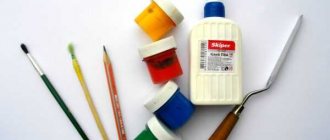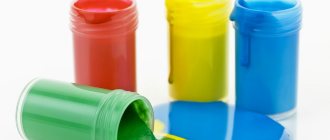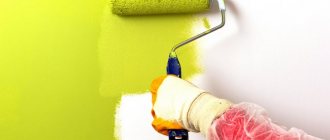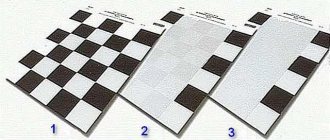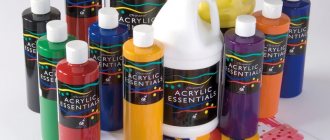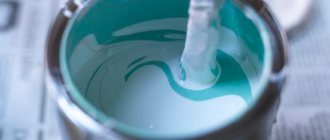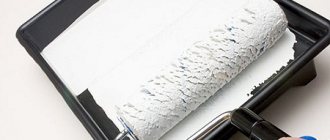How to dilute acrylic paint?
Acrylic composition is a type of modern water-based (water-dispersed) paints. Due to its many positive properties (environmentally friendly, reliable, quick drying), this solution is perfect for painting indoor and outdoor surfaces. Acrylic mixtures are also actively used for decoration and painting; there are special options for various materials.
In terms of consistency, a water-based acrylic solution is most often a rather thick mixture that needs to be diluted. To choose the optimal diluent, you need to pay attention to the composition. The main component that gives this group of paints its name is water; the base can make up up to 50–60% of the solution.
Thus, the solvent is water, which must meet certain requirements to obtain an ideal result:
- Temperature. To dilute the mixture, the liquid must be within 20 degrees. If façade paint is used, it is 4–5 degrees higher than the street level (minimum 15–18 o C).
- No impurities. It is recommended to use distilled water, which does not contain foreign substances. If such a composition cannot be obtained, then the liquid is first brought to a boil and settled.
Features of diluting acrylic with water
To properly dilute acrylic paints, you need to know the proportions that allow you to achieve different results:
- Ratio 1:2. If there are two parts of water to one part of the coloring mixture, then such a solution turns out to be quite liquid. It adheres well to the brush, but leaves streaks behind, so it is better to apply it with a fleecy roller. The mixture is suitable for creating a base for a base coat.
- Proportion 1:1. This composition is used to obtain the base layer. It has good viscosity and fits perfectly onto the surface. After it, a composition similar in consistency can be applied, but it is better to dilute the final layer minimally.
- A less common option is when the paint needs to be dissolved in five parts of water. This method is used by professional designers or artists when they need to tint textured elements. The composition is quickly absorbed, and the layer is barely noticeable.
What else is used to dilute paint?
Although water is the optimal solvent that is available to everyone, there are special liquids - thinners. According to their structure, they are divided into several varieties:
- Universal. Suitable for all standard compositions used to decorate walls, ceilings and facades.
Each option is used according to the recommendations provided by the manufacturer. Experimental breeding is often necessary to achieve individual results.
Types of primers and technology for their application
I’ll say right away that the quality of wall preparation directly depends on the choice of primer . Therefore, I will talk about the highest quality options that you can use. We will also figure out how to properly apply the solution, since the technology is very different from traditional wall primer.
It is not necessary to remove the firmly adhered oil coating if you know how to prepare it for finishing.
Paint selection
There are two options:
- Special compositions for old paint;
- Adhesive primer.
Special options suit the job best
The first type of product is preferable, but if there is nowhere to buy this option, you can also use contact primers. Let's look at both solutions in order and start with special compounds:
- This primer for oil paint for painting is suitable for application to all smooth, slightly absorbent surfaces. It allows you to get a base that can be finished in any way;
- When processing, it is not necessary to even sand the old finish;
- After drying, a semi-matte film is formed, on which both paints and putties adhere well.
The products of the following manufacturers have proven themselves best:
- Primer for oil paint "Optimax" fits perfectly on all materials. If necessary, you can dilute the composition with water (no more than 10% of the volume). Its main advantage is its low price; for a package weighing 2.5 kg you will pay about 120 rubles;
- Neomid compositions are considered the highest quality among all and are popular among professionals. They have excellent adhesion even without first sanding the old layer. But this option will cost significantly more; for a package weighing 5 kg you will have to pay about 500 rubles;
Application of acrylic thinners
Specialized formulations are also divided according to drying speed. The correctly selected option allows you to perform work even in difficult conditions.
The following varieties are found:
- Slow. Suitable for external and internal work if temperatures are very high. The fact is that due to the rapid evaporation of ordinary water, the coating does not acquire the desired properties and may be destroyed. And slowly evaporating thinners make it possible to perform the work correctly, as a result of which the surfaces receive reliable protection.
- Average. This is a universal composition, the best option for working inside a house or apartment.
- Fast. They are used mainly outside, including at low temperatures. In such conditions, the paint, with simple dilution, does not have time to adhere to the base, and a quick thinner solves this problem.
How paints are diluted for painting
Thinning acrylic-based art paints is a more responsible process. The fact is that the volume of such compositions is small, so you cannot make a mistake with the proportion.
Dissolution is carried out using a regular pipette; it allows you to dose the amount of diluent used. Wet palettes are selected for mixing; this will eliminate the possibility of rapid drying. Getting the right consistency depends on the desired result and the job being done, but it is best to test individually.
If too thinned, add some paint or leave the mixture to dry.
How to dilute acrylic dye for painting on a wall
Dye in tubes is used to create designs. It is quite possible to use it to make a drawing on the wall, and if you are an artist, then you can easily use it for canvas. But here too there are some peculiarities.
Let's look at the details of this breeding:
- In this case, a pipette is also used to adjust the dosage. The process takes place on the palette, it can be wet or dry. You can also dilute for testing simply in the cap of the tube;
- If you are making a drawing on canvas, or on a wall where there is already a base. Then the dilution must be done on a damp palette. Dry dye will dry out extremely quickly;
- The ratio of water and paint will be determined by the desired brightness of the drawing. The more water there is, the less brightness will be. Here you just need to experiment.
What to do if acrylic paint has dried out?
It happens that due to improper storage at home, even in a short time, the composition manages to thicken or dry out greatly. To correct this situation, you must do the following:
- The acrylic mixture differs from simple enamels in that it can be diluted at different degrees of drying of the base composition. So, when the viscosity increases, water is simply added to the solution and mixed well. The main thing is to close the container tightly. This rule also applies to cases where there is a small residue after painting.
- If clots are observed in the composition, then add a little alcohol to the water. The mixture is thoroughly mixed until the lumps completely disappear. A small amount of solvent is poured on top and the container is well sealed.
It is more difficult to restore a dried composition. To do this, a whole set of actions is performed:
- The hardened material is removed from the container and broken into small pieces. It is important to prevent the entry of dirt and dust.
- Lumps must be crushed as much as possible. To do this, you can use a piece of pipe or fittings of suitable diameter.
- The resulting powder is poured into a convenient container and filled with well-heated water. The solution is not stirred, but shaken several times. After a minute, the liquid is drained.
- A new portion of hot liquid is added and the procedure is repeated.
- A special diluent is poured in and the mixture is stirred well until the desired viscosity is obtained. But such a material will no longer have all the properties.
If the paint has dried to a stone state, then it is better not to restore it. Although you can follow the previous procedure, which will require effort and time, the resulting composition is best used for utility rooms.
Acrylic paint is a safe, non-toxic paint and varnish material made on the basis of pigment, a binding component, and water. After evaporation and complete drying of the water base, a frost-resistant, elastic, cracking and delamination-resistant protective coating is created. This type of paint is used for painting wooden, metal, and plastered surfaces.
How to prevent paint from drying out
To avoid acrylic drying out in a jar or tube, you need to tightly close the lid of the container. For construction work, dye is often purchased with a reserve in order to be able to restore the damaged coating with an exact match of the shade.
The mixture can be stored in a pantry, warm garage, basement and other rooms. Before closing, it is necessary to thoroughly wipe the lid and neck of the jar from the coloring composition.
From time to time it is necessary to check the expiration date of paint in closed cans and its consistency in open ones. If the acrylic has thickened, you need to immediately restore it with water before the polymer base becomes dry.
When painting large surfaces, dilute the paint in portions and cover the jar tightly with a lid. To paint the car evenly, you need to slightly dilute the dye before applying the second coat. Due to the active evaporation of solvents, acrylic enamel has time to thicken while the master applies the first layer of coating.
The quality of restored dry paint is significantly reduced, so it is advisable to revive the polymer emulsion before it dries completely. To make working with the composition easier, you can use both thinners and solvents. The former allow you to adjust the consistency, while the latter bind the acrylic and speed up the curing of the finished coating.
Diluting acrylic paints with water
The basis of acrylic paints and varnishes is water, so it is advisable to use it to achieve the required consistency. An important point: you need to use only clean and cold water, standing for several hours or distilled, to prevent interaction between the components of the paint and varnish material and the thinner.
- dilution with water 1:1 - the material can be used to create a base layer, the paintwork lays down smoothly, without smudges or sagging, forming a uniform coating that effectively protects the surface from corrosion and aggressive environmental influences;
— 1:2 – the consistency is more liquid, allowing you to create a thin and even layer, the paintwork material saturates the brush or roller well;
– 1:5 – creates “colored water”, which is used to color textured details; the composition is well absorbed and fills depressions and other depressions on the surface;
— 1:15 – the proportion is not used often, it is intended to create a transition between tones (gradient); in fact, it is no longer paint, but colored water.
After applying acrylic water-based paint and varnish material, you must immediately thoroughly clean the tool used. This is explained by the fact that after drying, water-based acrylic paintwork becomes water-resistant. And, accordingly, rollers, brushes and other painting tools, once dry, cannot be cleaned.
Additional recommendations
Working with acrylic paints has nuances and secrets. Here are some of them:
The water must stand for 2-3 hours so that the impurities settle to the bottom. Only after this can it be used to dilute acrylic paints.
When applying the composition using a spray gun, work with branded solvents, adhering to the proportions recommended by the manufacturer. This way you will get a liquid of uniform consistency and achieve uniform coloring of the surface.
Rinse brushes and rollers thoroughly, especially if the work was performed with a highly diluted liquid. This composition is difficult to notice, so the particles remain between the villi. If you subsequently use paint of a lighter shade, the color will be spoiled.
Add the diluent to the composition in portions, thoroughly mixing the composition after each dose. To do this, use a special mixer.
It is not recommended to purchase the material “back to back” - it is advisable to leave a small amount of paint unused. This is necessary for spot restoration of the surface in case of accidental damage.
Regardless of what you choose to thin your acrylic paint with, test the product with a small amount of colorant. If you notice the formation of lumps, you will have to choose another option.
Dilution with special acrylic thinners
Dilution with water or water with alcohol is only permissible when using a roller or brush. Paint sprayers and spray guns (painting equipment) require the use of acrylic thinners, the brand of which must be indicated by the manufacturer on the packaging. They have a specific smell and transparent appearance. The required amount of addition of such liquid depends on the scope of application, temperature and humidity of the external environment. Depending on the composition, acrylic solvents create a matte or glossy layer on the surface. Different coloring effects are achieved using a certain proportion, which is usually indicated on the thinner packaging.
Advantages of using acrylic solvent:
— accelerated drying time;
— the ability to create a matte or glossy surface;
— formation of an even layer without smudges and white deposits;
— chemical purity, compared to water;
— increased stability of paint characteristics.
Preparing for work
If you decide to use acrylic dyes to achieve your goals, then you need to start preparing. Their beauty lies in their wide range of applications. You can create works of art by painting pictures, use them in repairs and decoration, and such paints can even be used for furniture restoration.
But using acrylic paint in its pure form will not bring the desired effect. Due to the thickness of the dye, the painted surface will reflect the relief pattern of the instrument with which the composition is applied. Therefore, diluted solutions are used.
Dyes are produced for various purposes: for external or internal work, for creating paintings by numbers. Therefore, when answering the question of how to dilute acrylic paint for walls, it is important to study the instructions. The thinner can be either water or acrylic solvent.
Thinning dried acrylic paint
To dilute completely dried acrylic paint, it is advisable to use hot water, first grinding the acrylic well. The procedure must be repeated several times, draining the water each time until the paint warms up. The last portion of boiling water is left in the jar and stirred thoroughly until a homogeneous mass is obtained.
When using solvents, it is worth remembering that for dilution they are added to the paint in small portions, and not vice versa.
Acrylic paint has many advantages, which makes it almost universal. Unlike oil paint, acrylic paint can be diluted with water. The final coloring result depends on how this is done.
How to restore dried acrylic
Acrylic is no less popular among artists. These paints, packaged in small metal tubes, often harden and have to be resuscitated. Those who encounter this phenomenon for the first time do not know what to do. The problem is very easy to solve. But first you need to decide on the condition of the paints. At first glance it may seem that they have dried out, but in fact they have simply thickened.
How to paint chipboard with your own hands at home, 5 best compositions
If with a certain amount of force you can catch a little of the mixture with a brush, it has simply frozen. In this case, the composition should stretch a little. You can soak the paint very quickly with a few drops of water or a special thinner.
Zakharova Irina Yurievna
Cleaning professional with 15 years of experience. Our best expert.
When the substance resembles plastic and is taken in a whole piece, then it has already dried. Solving this problem is more difficult. If a piece can be written on paper, then it can still be restored. For this, boiling water and a solvent are used.
- if the paint has dried, in order to avoid moisture evaporation, it should be diluted in a small container;
- A tight-fitting jar lid will help get rid of excessive drying;
- It is recommended to wash all tools immediately after completion of work;
- Completely removing dried acrylic paint is a labor-intensive process. Therefore, it is better to cover the surrounding area with protective materials in advance.
The quality of the covering layer directly depends on the degree of viscosity of the paintwork material. Mistakes made can affect not only the appearance of the painted surface, but also the service life.
What is acrylic paint
It refers to water-dispersed paints and varnishes. If you decipher it, all the features of the paint immediately come to the surface. Water, acrylic resin and tiny particles of coloring pigment are shaken up so that the droplets are evenly distributed among each other - this is called dispersion.
Thus, acrylic paint consists of the following components:
- water,
- acrylic resin,
- dye,
- filler (larger paint particles that make the coating more durable, adhesive, and matte or glossy),
- additional components that make each brand unique.
Operating principle After the paint is applied, it begins to dry - water evaporates from it. Resin droplets connect and create a monolithic layer that reliably embeds the coloring pigment.
Properties after drying
In liquid form, it is a light, almost odorless substance that is easy to apply and also easy to wash off. However, acrylic paint adheres excellently to almost any surface (which makes it universal), be it stone or plastic.
The hardened layer is resistant to abrasion, fading, and can be washed - acrylic paint practically does not need varnishing for protection. Additional components can further increase its strength, resistance to natural vagaries, etc.
Advantages of acrylic paints:
- environmental friendliness,
- absence of a pungent odor, which means safety when working in a nursery, bedroom, etc.;
- versatility,
- quick drying,
- a wide range of colors and shades (especially if you use colors).
Why dilute
Why, one might ask, reduce the concentration of such high-quality material? This is often necessary because the paint has been left under a loose lid for a long time, and the consistency has become too thick.
Another option is when you need more liquid paint, even to the point of tinted water. For example, to paint a textured surface, curves, hollows, and other reliefs and openwork details.
How to dilute with water
Since water is part of the paint, it is possible and even preferable to dilute it. As a rule, 4 proportion options are used:
- 1:1 - normal consistency, quite thick, used for the base layer, the paint applies evenly, without drips;
- 1:2 - more liquid, optimal for painting openwork parts or for painting with impregnation;
- 1:5 - consistency close to “colored water”, suitable for textured and relief surfaces, including vinyl wallpaper for painting, bas-reliefs, etc.,
- 1:15 - colored water, used to create gradients, toning, etc.
Water should be poured in a thin stream, stirring constantly and achieving an absolutely uniform paint structure. A construction mixer will be superfluous; a rod, stick or wooden plank is enough, but you need to move it quite intensively.
Water + alcohol
In some cases, when the paint has become particularly thick, it can be diluted with water mixed with alcohol. Such a coating will dry somewhat faster due to volatile alcohol, however, the quality of the layer will be worse.
